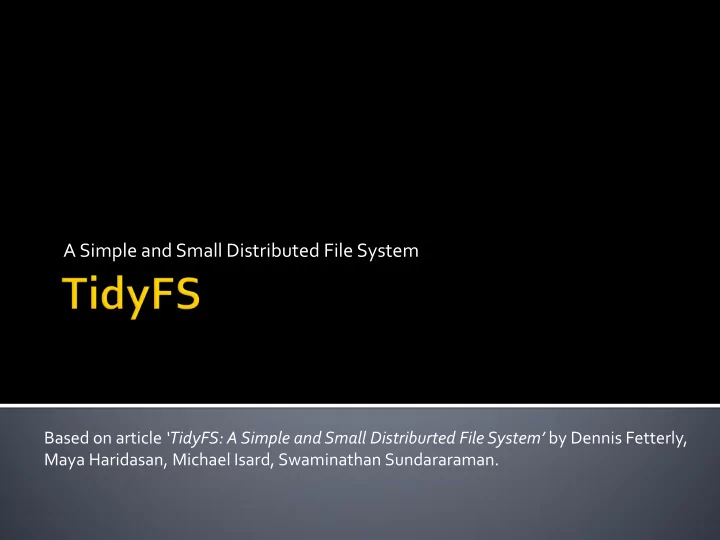

A Simple and Small Distributed File System Based on article ‘ TidyFS: A Simple and Small Distriburted File System’ by Dennis Fetterly, Maya Haridasan, Michael Isard, Swaminathan Sundararaman.
1. Parallel computations on clusters 2. Shared nothing commodity computers 3. High-throughput 4. Sequential access 5. Read-mostly 6. Fault-tolerance 7. Simplicity Main competitors: Source : http://pl.wikipedia.org/w/index.php?title=Plik:Us-nasa-columbia.jpg&filetimestamp=20050116090033
1. Writes are invisible to readers until commited. 2. Data are immutable. 3. Replication is lazy. 4. Relying on the end-to-end fault tolerance of the computing platform. 5. Using native IO. Strongly connected with DryadLINQ system (parallelizing 6. compiler for .NET) and Quincy (cluster-wide scheduler).
Source: http://niels85.wordpress.com/2011/03/24/review-1982-blade-runner-top-250-at-imdb/ Data Metadata • Stored on the compute • Stored on dedicated nodes (distribution) machines (centralisation) • Immutable • Mutable • FS does replication. • Servers should be replicated.
Streams and parts • Data are stored in abstract streams . • A stream is a sequence of parts . • Part is atomic unit of data. Each part is replicated on multiple cluster computers. Part can be a member of multiple streams. Streams can be modificated, parts are immutable. Part may be: Single file. Colection of files of more complex type (SQL databases). Streams has (possibly infinite) lease time. Streams are decorated with extensible metadata. Streams and parts are fingerprinted.
Read Write Remarks Choose existing stream or create a new one Choose stream Typically we write on the local hard drive. Optionally we can Pre-allocate set of simultaneously write parts ids Fetch the sequence multiple replicas. of part ids Choose id and get write path Request a path to the choosen part Use native interface to write data Use native interface Sending the part size to read data and fingerprint Available native interfaces: NTFS, SQL Server, (CIFS).
PROS CONS Loss of control over parts Allows applications to choose access patterns. the most suitable parts access Loss of generality. patterns. Lack of automatic eager Avoids extra indirection layer. replication. Allows to use native access- Some parts can be much control mechanisms (ACLs). bigger than other ones. Simplicity and performance. Problems with replication and Gives clients precise control rebalancing. over the size and contents. Sometimes a defragmentation is needed.
TidyFS Explorer Metadata server 1800 lines 9700 lines Node service 950 lines Client library 5000 lines Source : http://the-moviebuff.blogspot.com/2011/07/winnie-pooh-updating-classic.html
Source: http://moviesandsongs365.blogspot.com/2011/05/movie-of-week-2001-space-odyssey-1968.html Stores and tracks: Parts, streams, names and id’s mappings. Per-stream replication factor. Locations of each replica. State of the each computer: ▪ ReadWrite ▪ ReadOnly ▪ Distress ▪ Unavailable Replicated component. Uses Paxos algorithm for synchronization.
Periodically performs maintanance actions: Reporting the amount of free space. Garbage collection. Part replication. Part validation. ▪ Checking againts latent sector errors. Runs periodically (each 60 seconds). Gets from metadata server two list: A. List of parts that the server believes should be stored on the computer. B. The list of parts that should be replicated onto the computer but have not yet been copied.
The list contains the parts that should be already stored. Two kinds of inconsistency: A. We do not have expected part -> error 1. Create new replicas. B. We have unexpcted parts -> prepare for deletion 1. Send the list of parts to be deleted. 2. Delete confirmed parts. ▪ Metadata server is aware of parts currently written but not yet commited.
List consists of the parts that should be replicated on the computer. 1. Obtain paths to the parts. 2. Download parts. 3. Validate fingerprint. 4. Acknowledge the parts existence.
Aims: Spread replicas across the available computers. 1. ▪ It enables more local reads. ▪ TidyFS is aware of network topology. ▪ First write if a part is always on the local hard drive. ▪ Depending on the computional framework’s fault-tolerance. 2. Storage space usage should be balanced across the computers.
A. Always choose the computer with most free space. Can result in poor balance. B. Choose three random computers, and then selects the one with most free space. Acceptable balance (more than 2 times better than for A). Histogram of part sizes (in MB).
Research cluster with 256 servers. Real large-scale data-intensive computations. DryadLINQ and Quincy. Processes are being scheduled close to at least one replica of their input parts. Operating for a one year.
„We find, that lazy replication provides acceptable performance for clusters of a few hundred computers .” One unrecoverable computer failure per month, no data loss. Mean time to replication
READ AGE READ TYPE Proportion of local, within rack and cross Cumulative distribution of read ages. rack data read grouped by age of reads.
1. Direct access to part data using native interfaces. 2. Support for multiple part types. 3. Not general – tightly integrated with Microsoft’s cluster engine. 4. Leveraging the client’s existing fault-tolerance. 5. Clients has precise knowledge about parts sizes. 6. Sometimes defragmentation is needed. 7. Simplification. 8. Good performance in the target workload.
Source: http://religiamocy.blogspot.com/2010/08/moc-w-przewodach-czyli-roboty-w-star.html
Recommend
More recommend